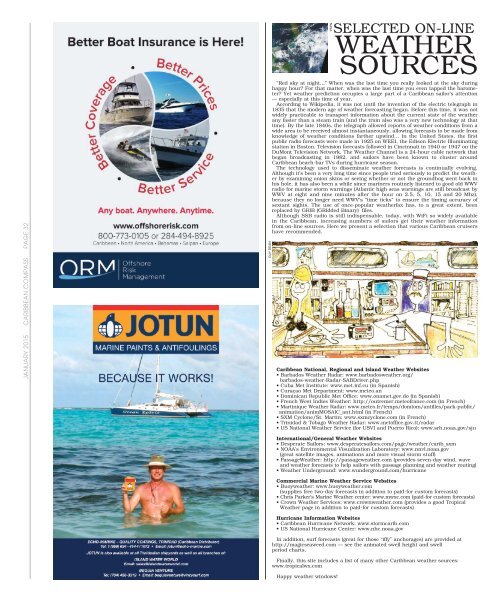Caribbean Compass Yachting Magazine January 2015
Welcome to Caribbean Compass, the most widely-read boating publication in the Caribbean! THE MOST NEWS YOU CAN USE - feature articles on cruising destinations, regattas, environment, events...
Welcome to Caribbean Compass, the most widely-read boating publication in the Caribbean! THE MOST NEWS YOU CAN USE - feature articles on cruising destinations, regattas, environment, events...
You also want an ePaper? Increase the reach of your titles
YUMPU automatically turns print PDFs into web optimized ePapers that Google loves.
NASA<br />
SELECTED ON-LINE<br />
WEATHER<br />
SOURCES<br />
JANUARY <strong>2015</strong> CARIBBEAN COMPASS PAGE 32<br />
GUY DEAN<br />
“Red sky at night…” When was the last time you really looked at the sky during<br />
happy hour For that matter, when was the last time you even tapped the barometer<br />
Yet weather prediction occupies a large part of a <strong>Caribbean</strong> sailor’s attention<br />
— especially at this time of year.<br />
According to Wikipedia, it was not until the invention of the electric telegraph in<br />
1835 that the modern age of weather forecasting began. Before this time, it was not<br />
widely practicable to transport information about the current state of the weather<br />
any faster than a steam train (and the train also was a very new technology at that<br />
time). By the late 1840s, the telegraph allowed reports of weather conditions from a<br />
wide area to be received almost instantaneously, allowing forecasts to be made from<br />
knowledge of weather conditions farther upwind… In the United States, the first<br />
public radio forecasts were made in 1925 on WEEI, the Edison Electric Illuminating<br />
station in Boston. Television forecasts followed in Cincinnati in 1940 or 1947 on the<br />
DuMont Television Network. The Weather Channel is a 24-hour cable network that<br />
began broadcasting in 1982, and sailors have been known to cluster around<br />
<strong>Caribbean</strong> beach-bar TVs during hurricane season.<br />
The technology used to disseminate weather forecasts is continually evolving.<br />
Although it’s been a very long time since people tried seriously to predict the weather<br />
by examining onion skins or seeing whether or not the groundhog went back in<br />
his hole, it has also been a while since mariners routinely listened to good old WWV<br />
radio for marine storm warnings (Atlantic high seas warnings are still broadcast by<br />
WWV at eight and nine minutes after the hour on 2.5, 5, 10, 15 and 20 Mhz),<br />
because they no longer need WWV’s “time ticks” to ensure the timing accuracy of<br />
sextant sights. The use of once-popular weatherfax has, to a great extent, been<br />
replaced by GRIB (GRIdded Binary) files.<br />
Although SSB radio is still indispensable, today, with WiFi so widely available<br />
in the <strong>Caribbean</strong>, increasing numbers of sailors get their weather information<br />
from on-line sources. Here we present a selection that various <strong>Caribbean</strong> cruisers<br />
have recommended.<br />
<strong>Caribbean</strong> National, Regional and Island Weather Websites<br />
• Barbados Weather Radar: www.barbadosweather.org/<br />
barbados-weather-Radar-SABDriver.php<br />
• Cuba Met Institute: www.met.inf.cu (in Spanish)<br />
• Curaçao Met Department: www.meteo.an<br />
• Dominican Republic Met Office: www.onamet.gov.do (in Spanish)<br />
• French West Indies Weather: http://outremer.meteofrance.com (in French)<br />
• Martinique Weather Radar: www.meteo.fr/temps/domtom/antilles/pack-public/<br />
animation/animMOSAIC_ant.html (in French)<br />
• SXM Cyclone/St. Martin: www.sxmcyclone.com (in French)<br />
• Trinidad & Tobago Weather Radar: www.metoffice.gov.tt/radar<br />
• US National Weather Service (for USVI and Puerto Rico): www.srh.noaa.gov/sju<br />
International/General Weather Websites<br />
• Desperate Sailors: www.desperatesailors.com/page/weather/carib_sxm<br />
• NOAA’s Environmental Visualization Laboratory: www.nnvl.noaa.gov<br />
(great satellite images, animations and more visual storm stuff)<br />
• PassageWeather: http://passageweather.com (provides seven-day wind, wave<br />
and weather forecasts to help sailors with passage planning and weather routing)<br />
• Weather Underground: www.wunderground.com/hurricane<br />
Commercial Marine Weather Service Websites<br />
• Buoyweather: www.buoyweather.com<br />
(supplies free two-day forecasts in addition to paid-for custom forecasts)<br />
• Chris Parker’s Marine Weather center: www.mwxc.com (paid-for custom forecasts)<br />
• Crown Weather Services: www.crownweather.com (provides a good Tropical<br />
Weather page in addition to paid-for custom forecasts)<br />
Hurricane Information Websites<br />
• <strong>Caribbean</strong> Hurricane Network: www.stormcarib.com<br />
• US National Hurricane Center: www.nhc.noaa.gov<br />
In addition, surf forecasts (great for those “iffy” anchorages) are provided at<br />
http://magicseaweed.com — see the animated swell height and swell<br />
period charts.<br />
Finally, this site includes a list of many other <strong>Caribbean</strong> weather sources:<br />
www.tropicalwx.com<br />
Happy weather windows!


















